Karl Bulla
Carl Oswald Bulla or Karl Karlovich Bulla (Russian: Карл Карлович Булла; 26 February 1855[1] or 1853[2] – 1929) was a German-Russian photographer, often referred to as the "father of Russian photo-reporting".[3]
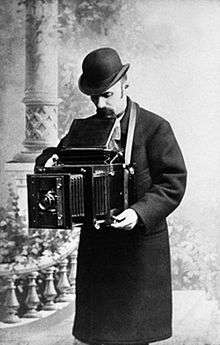
Biography
Carl Oswald Bulla was born in Leobschütz in Prussia (now Głubczyce, Poland). His exact birth year is unclear with some references citing 1853[2] then others citing 1855.[1] In 1865 the adventurous boy ran away from his family to St. Petersburg, Russian Empire. The reasons prompting the boy to choose Russia out of all possible destinations are as yet unknown.[3]
After arriving in St. Petersburg, Bulla started to work as a delivery-boy in the firm Dupant that made and sold photography supplies. Soon his responsibilities included handmaking (coating and sensitizing) of the photographic glass negative plates. At the age of twenty Bulla opened a small factory producing "momentary dry bromine-gelatin plates". Buying the readymade photographic materials was much more convenient than handmaking their own and soon Bulla's plates became popular, selling not only in St.Petersburg but across the whole Russian Empire.[1] In February 1876 Bulla requested his naturalization and in July 1876 became a subject of the Russian Empire.[1]
In 1875 Bulla opened his first photographic studio at 61 Sadovaya Street and soon became a fashionable photographer. For ten years he worked there doing pavilion portrait photography. Then in 1886, he received the permit from the St.Petersburg Police allowing him to take pictures everywhere. While he did not abandon studio photography (in fact he opened two more studios: on the Catherine Canal and on Nevsky Prospekt) but became more interested in photography of city life.[1]
At the end of the 19th century, newspaper printing technology allowed the publishing of photographs. In 1894 Russian Department of Post and Telegraphs also allowed the use of postcards. Both events significantly increased the demand for photographs.[1] In 1895 Bulla stopped his production of photographic supplies[1] and put all his energy into photography. In his advertisement, he wrote "The oldest photographer-illustrator Karl Bulla photographs for the illustrated magazines anything and anywhere without limits from the landscape or the building, indoor or outdoor day or night at the artificial light".[2]
Indeed, he photographed everything and anything: Life of Tsar family and assemblies of anti-government intelligentsia, stars of scene and manual workers, palaces and hostels for homeless, even such exotics as gay parties.[4] Bulla was on the editorial board of many magazines including popular Niva.[1] In 1910s the annual revenue of the firm "Bulla and Sons" reached 250 thousand roubles.[1]
In 1916 Bulla passed the management of the firm "Bulla and sons" to his sons Alexander and Viktor and moved to Ösel Island (currently Saaremaa, Estonia). He lived a quiet life there, photographing the local ethnographic material and teaching Estonian boys the basics of photography until his death in 1929.[1]
The sons

After the retirement of Karl Bulla, his firm was managed by his sons, Alexander and Viktor. Viktor Bulla was a notable photo-reporter in his own right. He was the author of a series on the Russo-Japanese War and World War I.[3] At that time, before the invention of the telephoto lens, photography was a very difficult and dangerous mission.[3]
Later Viktor Bulla made photographs of the October Revolution and the Russian Civil War. He was appointed the Chief Photographer of the Leningrad Soviet. He took a lot of photographs of Vladimir Lenin and other bolsheviks. In 1938 during the Great Purge he was arrested, accused of being a German spy and shot.[3]
The life of Andrey Bulla also ended tragically. He was arrested in the early 1930s and sent to White Sea – Baltic Canal labor camps. He returned after five years and soon died.[2]
Archive
In 1935 the son of Karl, Viktor Bulla donated to the State Archive of Leningrad District 132,683 negatives of Bulla's photographs. The archive grew and now consists of more than 200,000 negatives of works by Karl Bulla and his sons.[3] All the photographs in the archive are in the public domain and are a favorite source of illustrations of life in Saint-Petersburg.[1]
In 2003 there was a large exhibition of Bulla's prints celebrating 300 years of Saint-Petersburg and 150th birthday of Karl Bulla (by the 1853 version).[5] People of Saint-Petersburg put a bronze sculpture of Karl Bulla on Malaya Sadovaya Street near the former studio of Karl Bulla. The sculpture shows a photographer with an ancient camera and an umbrella photographing a bulldog.[6]
Some works
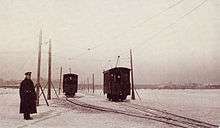 Trams on the frozen Neva River
Trams on the frozen Neva River Street scene
Street scene Stonemasons, 1900s
Stonemasons, 1900s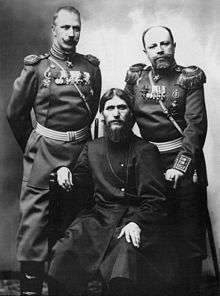 Grigory Rasputin, Major-General Putyatin and Colonel Lotman, 1904
Grigory Rasputin, Major-General Putyatin and Colonel Lotman, 1904 Collapse of the Egyptian Bridge
Collapse of the Egyptian Bridge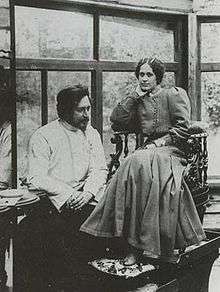 Leonid Andreyev and his wife, Anna
Leonid Andreyev and his wife, Anna Deputies of the disbanded State Duma arrive to Vyborg to sign an anti-government Vyborg Manifesto, 1906
Deputies of the disbanded State Duma arrive to Vyborg to sign an anti-government Vyborg Manifesto, 1906
 1900s
1900s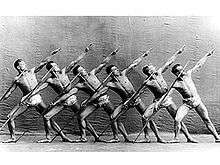 1900s
1900s Homeless Shelter, 1910
Homeless Shelter, 1910
 Ilya Yefimovich Repin reads the announcement of Leo Tolstoy death. Present Korney Chukovsky and Nordman-Severova (Repin's wife).
Ilya Yefimovich Repin reads the announcement of Leo Tolstoy death. Present Korney Chukovsky and Nordman-Severova (Repin's wife). Opening of the Hercules club, 1912
Opening of the Hercules club, 1912 Feodor Chaliapin and his friends ice skating, 1914
Feodor Chaliapin and his friends ice skating, 1914 Apraksin Dvor on fire, July, 1914
Apraksin Dvor on fire, July, 1914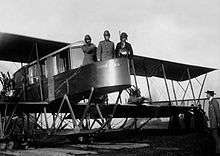 Igor Sikorsky, Genner and Kaulbars aboard airplane Russian Vityaz, 1915
Igor Sikorsky, Genner and Kaulbars aboard airplane Russian Vityaz, 1915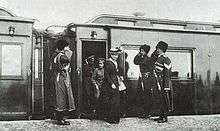 Nicholas II, Tsarevich Alexei and Alexandra Fyodorvna arrive to Stavka, May 1916
Nicholas II, Tsarevich Alexei and Alexandra Fyodorvna arrive to Stavka, May 1916
References
- Karl Karlovich Bulla in Encyclopedia Peoples.ru (in Russian)
- Karl Bulla and Sons Archived 2007-06-13 at the Wayback Machine article on Artproject.ru (in Russian)
- Karl Bulla: The Father of Russian Photo-reporting Archived 2012-02-07 at Archive.today "Глаза и уши Петербурга", 2004
- "Gay Camp, Old Russian Style". Archived from the original on 2010-07-11. Retrieved 2007-05-18.
- Karl Bulla:Classic of the National Photography Museum.ru (in Russian)
- Memorial to a photographer Archived 2009-11-12 at the Wayback Machine with photographs of the memorial (in Russian)
| Wikimedia Commons has media related to Karl Bulla. |